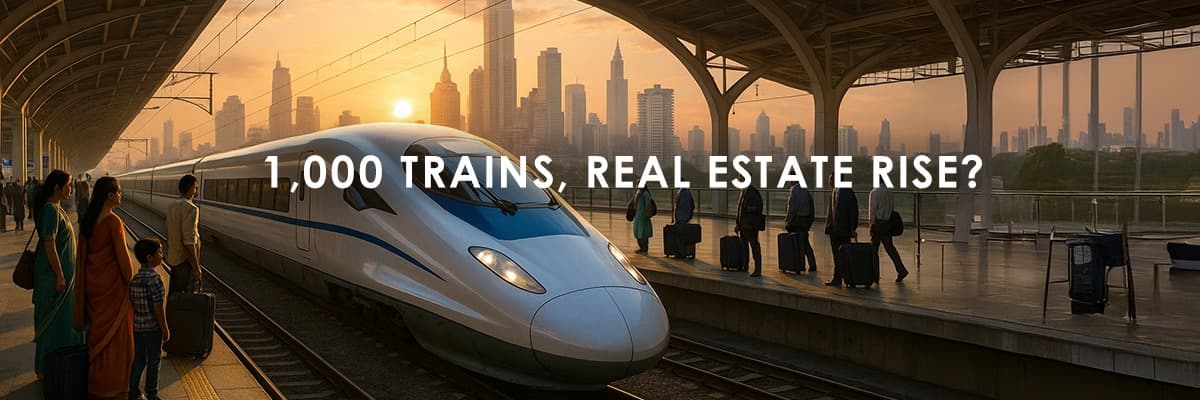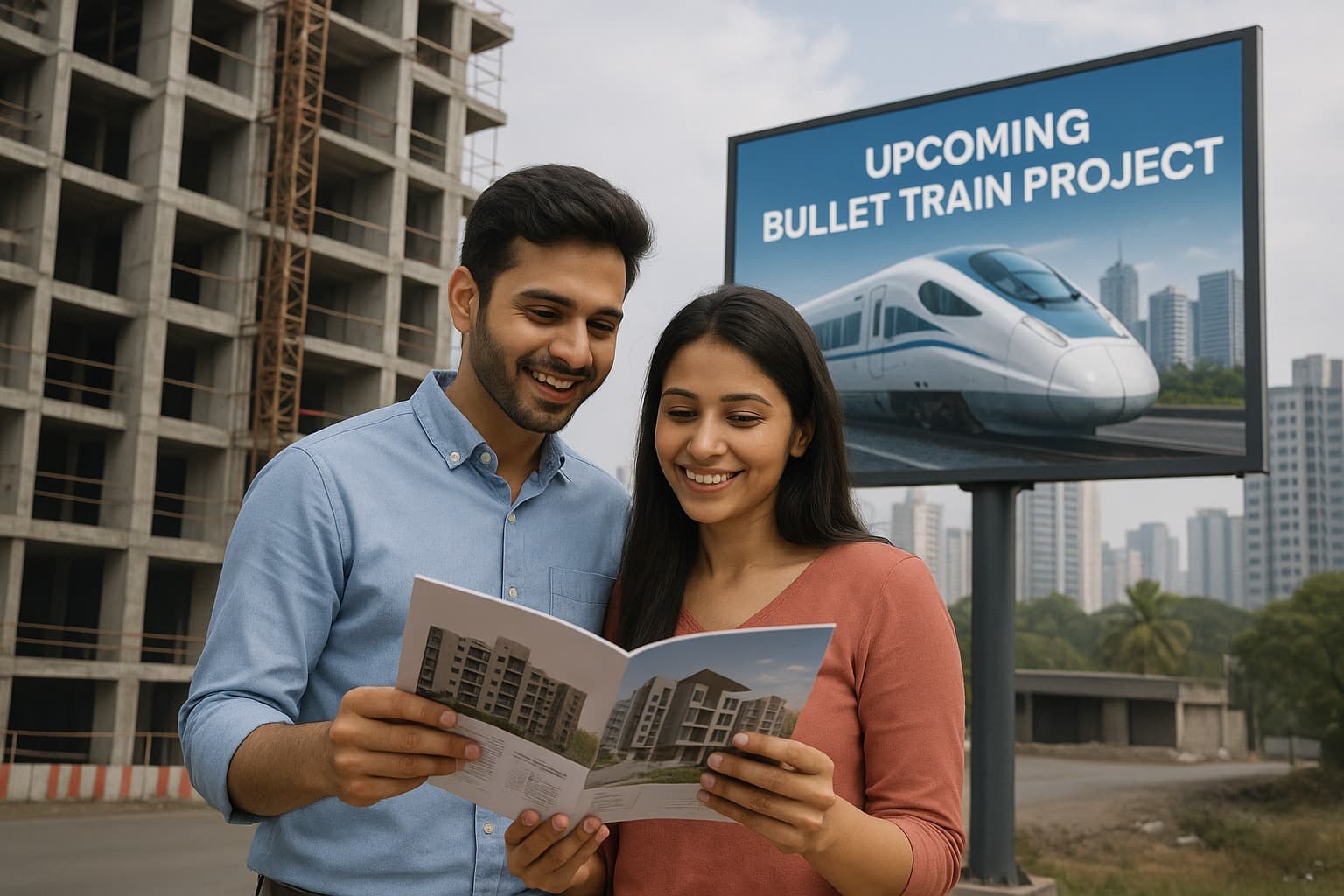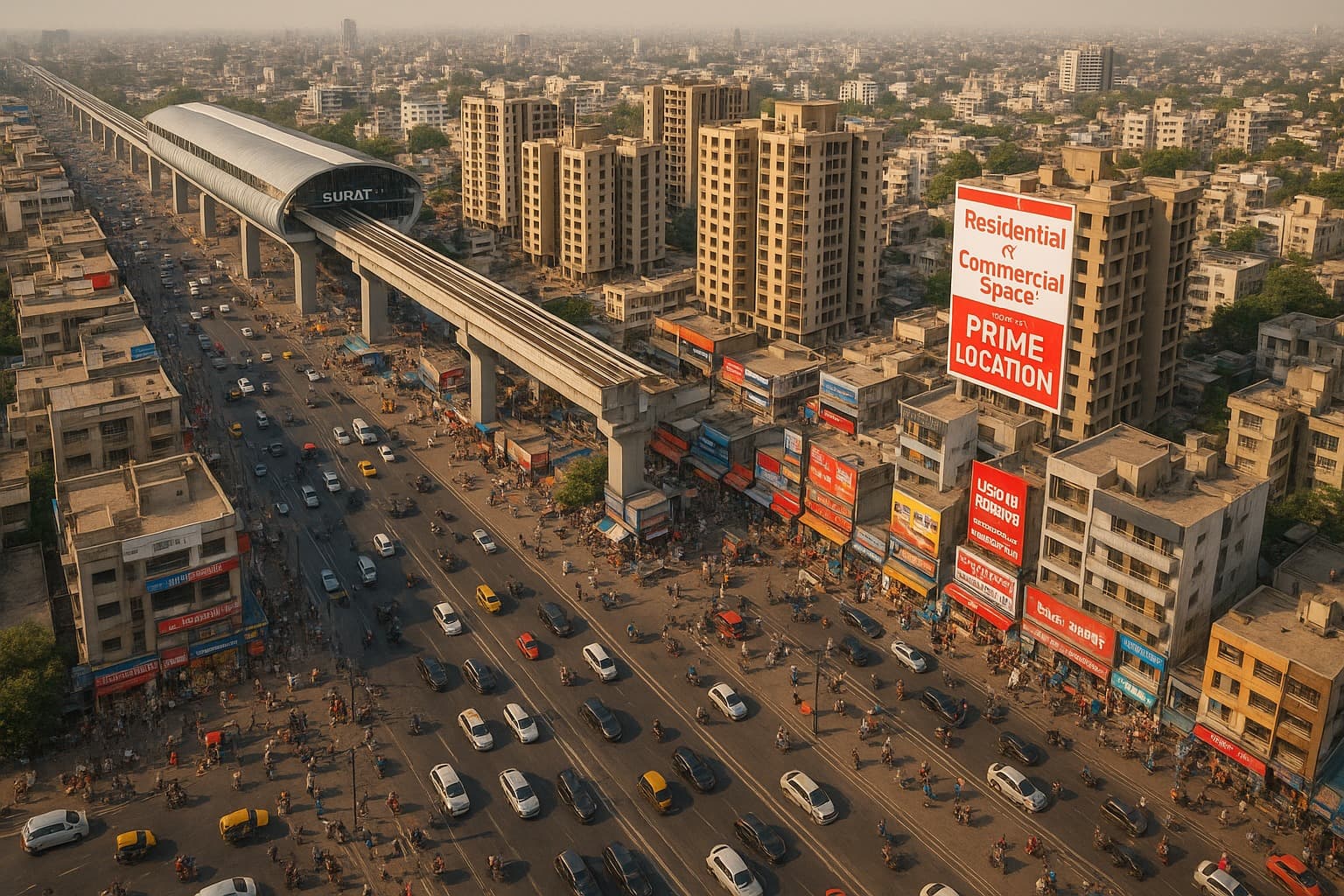1,000 New Trains & Bullet Train India 2025: Fueling Real Estate Growth
Summary
India's 2025 railway expansion, featuring 1,000 new trains and bullet train corridors, is set to revolutionize real estate and commuting. This initiative promises to connect cities, boost local economies, and make housing more accessible.

There’s something inherently magical about trains in India. They don’t just move people; they move dreams, aspirations, and lives. From the early morning chai in a Mumbai local to the rhythmic hum of the sleeper class in the middle of the night, trains are woven into the very fabric of Indian life.
Now, imagine this: in 2025, Indian Railways is rolling out a mega plan of 1,000 new trains, along with bullet train corridors like Mumbai-Ahmedabad, Pune-Mumbai, and others in the pipeline. This isn’t just transportation—it’s a transformation of how India lives, works, and dreams, with a ripple effect on real estate across the country.
The Mega Vision
The scale of this plan is breathtaking:
1,000 new trains connecting cities, towns, and smaller districts.
Bullet train corridors slashing travel times dramatically; Mumbai to Ahmedabad in under three hours.
Expanded suburban rail networks making commutes easier, smoother, and more reliable.
For daily commuters, this is life-changing. Imagine not enduring a 6-hour train ride to work but arriving fresh, energized, and ready. And for property buyers and investors, it’s a golden opportunity corridor stretching across India.
How Bullet Trains Transform Real Estate
When a bullet train reaches a town, life changes. A place that was a three-hour commute suddenly becomes one hour away. Villages, small towns, and suburbs that were once “too far” now become prime real estate.
The impact is not hypothetical:
Japan: Shinkansen bullet trains turned sleepy towns into thriving cities, driving up property values.
Europe: High-speed rail connected regions, boosting small-town economies and real estate markets.
India is about to witness the same phenomenon. From Borivali to Surat, Vadodara to Pune, towns along bullet train corridors are set to become hotspots for housing, commerce, and lifestyle growth.
Cities and Towns Set to Boom
Mumbai-Ahmedabad Corridor: Intermediate towns like Vapi, Surat, and Vadodara are already seeing attention from developers and investors.
Pune-Mumbai: Faster connectivity means Pune suburbs become viable for Mumbai commuters.

Nagpur-Hyderabad & Delhi-Kolkata Routes: Previously distant towns will now see residential and commercial developments rise rapidly.
In essence, connectivity equals demand, and demand drives property growth.
Human Stories – The Emotional Side of Trains
Let’s pause and get human. Trains change lives. Not just in convenience, but in emotion.
A young couple in Surat dreams of moving to Mumbai for better schools and jobs but can’t afford the commute today. With bullet trains, Mumbai becomes reachable—suddenly their dream feels tangible.
A retired couple in Vadodara decides to buy a weekend home near the Ahmedabad corridor. What was once a 5-hour drive is now a 90-minute train ride. They can spend weekends with family without fatigue.
A small-town entrepreneur opens a café near a future bullet train station, anticipating the influx of commuters, professionals, and tourists.
These are real lives, real dreams, and real property demands that emerge from improved connectivity.
Developers and the Early Movers
Developers are already repositioning themselves.
Land near upcoming bullet train stations is being purchased aggressively.
Projects branded as “bullet train ready” are attracting premium pricing.
Mixed-use developments with residential, retail, and office spaces are planned along these corridors.
Even towns once considered secondary—small cities in Maharashtra, Gujarat, and Uttar Pradesh—are seeing skyrocketing investor interest. The rule is simple: where the train goes, growth follows.
Families, Commuters, and Real Estate Dreams
Mumbai, Pune, Surat, Vadodara, Ahmedabad—each city has a human story intertwined with these railway expansions:
Rahul and Priya, a young IT couple in Pune, book a new apartment near the upcoming high-speed train station. Commutes are cut in half, weekends are longer, and the stress of city life is balanced by proximity to green spaces.
Anjali, a schoolteacher in Vadodara, invests in a small apartment along the corridor. She dreams of having her daughter study in Ahmedabad while staying close to family—something impossible before the new railway projects.
A retired professor in Surat buys a small home near the station to enjoy city culture on weekends without sacrificing the calm of his hometown.
The mega railway plan isn’t just steel and concrete—it’s emotional infrastructure, turning aspirations into achievable realities.
Investment Opportunities
For investors, timing is everything.
Early acquisition pays off: Buying near a station before trains start running ensures high appreciation.
Focus on growth corridors: Intermediate towns often appreciate faster than already developed metro cities.
Mixed-use projects thrive: Residential, retail, and office spaces near stations attract better ROI.
Real estate here is not just an investment—it’s participation in city evolution. Schools, hospitals, and shopping centers emerge, creating thriving communities.
Challenges and Realism
No mega project is without obstacles:
Upgrading last-mile connectivity, roads, and infrastructure takes time.

Not every corridor will see instant property appreciation—patience is key.
Investors must navigate local regulations, approvals, and developer reliability.
Yet the promise outweighs the hurdles. Lives will improve, towns will thrive, and dreams will get closer.
The Broader Picture
This isn’t just about property prices. It’s about:
Lifestyle transformation: Families spend less time commuting, more time living.
Community growth: Local economies benefit from retail, hospitality, and services near stations.
Nationwide connectivity: Cities, small towns, and villages are no longer isolated; India becomes one living, breathing ecosystem.
1,000 trains, bullet corridors, and new suburban links aren’t just infrastructure—they’re catalysts for human opportunity.
Imagining a Day in 2025
Picture it:
Early morning, Pune: Commuters board a new express train to Mumbai, sipping chai and reading news on tablets. Children laugh in school uniforms, arriving fresh at city schools.
Vadodara: Retirees stroll along the boulevard near the station, watching new cafes and shops bloom, a tangible sign of progress.
Surat: Entrepreneurs bustle, opening stores and services for the growing commuter population, fueled by new opportunity.
In every carriage, every station, every apartment bought or sold, lives are transforming—small, human, powerful transformations powered by steel tracks and dreams.
Final Thoughts
India’s railway mega plan 2025 is more than trains and bullet corridors—it’s a story of human connection, real estate evolution, and dreams becoming accessible. Homes once unreachable are now within grasp. Families spend more time together. Entrepreneurs thrive. Towns grow into mini-cities.
Real estate isn’t just about money—it’s about life, memories, and community. And with 1,000 new trains and bullet train corridors, India’s cities, towns, and people are moving faster, dreaming bigger, and living fuller.
⭐ 100-Word Human Summary
India’s railway mega plan 2025, including 1,000 new trains and bullet train corridors, is transforming both commuting and real estate. Faster travel will make previously distant towns viable for living and work, bridging affordability and opportunity for middle-class families. Young professionals, retirees, and small-town entrepreneurs will all benefit from shorter commutes and growing economic hubs. Property near bullet train stations will see appreciation, creating thriving communities with schools, shops, and services. Beyond numbers, it’s profoundly human—these trains connect not just places but dreams, ambitions, and quality of life, rewriting how India lives, works, and invests.
